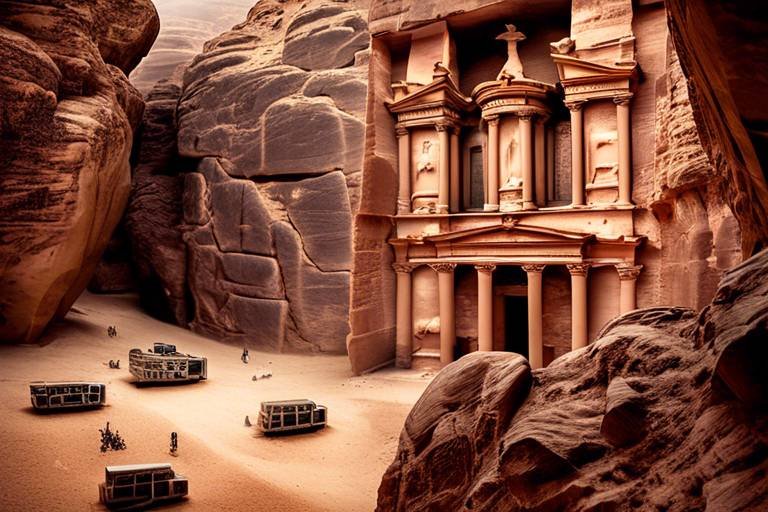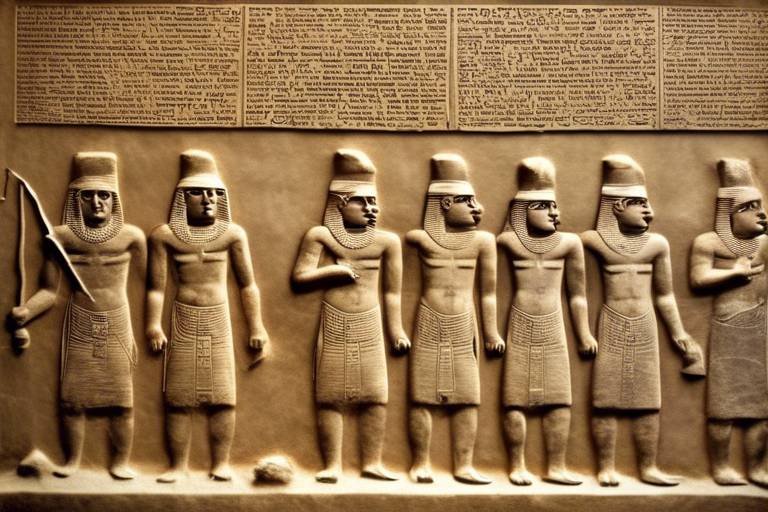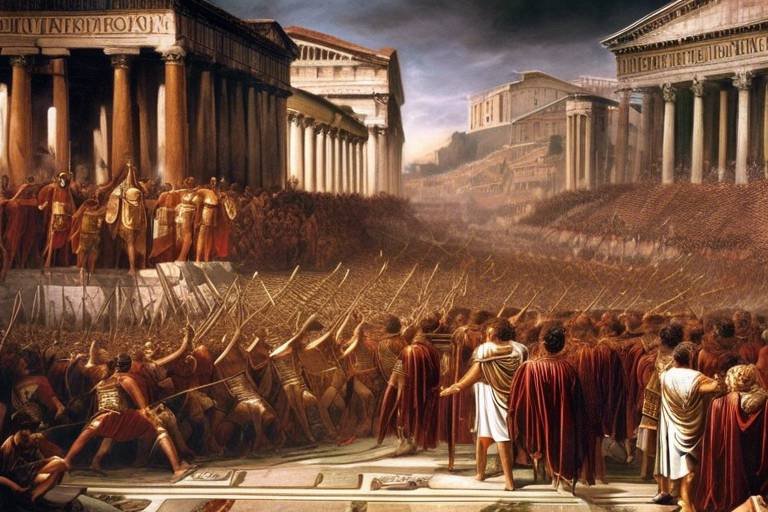The Incan Empire - Insights into Their Advanced Society
The Incan Empire, a civilization shrouded in mystery and marvel, offers a glimpse into an advanced society that thrived in the heart of South America. Known for their extraordinary achievements in various fields, the Incas left behind a legacy that continues to captivate the world. From their awe-inspiring architecture to their innovative agricultural practices, the Incas were a society ahead of their time.
One of the most remarkable aspects of the Incan Empire was their architectural prowess. The intricate stone structures they built, such as the iconic Machu Picchu and the formidable Sacsayhuamán, stand as testaments to their engineering ingenuity. The precision with which they fitted stones together without mortar is a marvel that still baffles modern architects. Their urban planning and construction techniques showcase a level of sophistication that is truly astounding.
Furthermore, the agricultural innovations of the Incas were crucial to the sustenance of their empire. In a terrain as diverse as the Andes, the Incas mastered the art of terrace farming, allowing them to cultivate crops at varying altitudes. Their irrigation systems were revolutionary, ensuring a steady water supply for their fields. The diversity of crops they grew, from potatoes to quinoa, played a vital role in supporting their population.
Delving into the social structure and governance of the Incas reveals a hierarchical society led by the powerful Sapa Inca. Nobility, commoners, and slaves each had their defined roles within the empire, contributing to its functioning. The administrative system, with its intricate organization of labor and resources, enabled the empire to flourish and expand.
Religion held a central place in Incan society, with beliefs revolving around nature and celestial deities like Inti, the Sun God. Rituals and ceremonies were conducted to honor these deities, and sacred sites held immense significance in their spiritual practices. The spiritual connection the Incas had with their environment shaped their worldview and daily lives.
Trade and economy were also integral to the Incan Empire's success. Their complex network of trade routes facilitated the exchange of goods, with agriculture, textiles, and precious metals playing key roles in their economy. The use of quipu, a system of knotted strings for record-keeping, exemplified their advanced economic practices.
As with many great civilizations, the decline of the Incan Empire was inevitable. The arrival of the Spanish conquistadors, led by Francisco Pizarro, marked the beginning of the end for the once-mighty empire. European diseases, warfare, and colonization took their toll, ultimately leading to the downfall of the Incas.
Despite their eventual defeat, the legacy of the Incas lives on in modern society. Their influence can be seen in the art, culture, and traditions of contemporary South America. The achievements of the Incas continue to inspire and shape the identity of the region, reminding us of the remarkable civilization that once thrived in the Andes.

Historical Background of the Incas
The Incan Empire was a remarkable civilization that thrived in the Andean region of South America. Originating in the 13th century, the Incas rose to power through a series of conquests and strategic alliances, eventually establishing one of the largest empires in pre-Columbian America. Their capital, Cusco, served as the heart of their vast territory, which extended from present-day Ecuador to Chile.
The Incan civilization was characterized by its sophisticated social structure, advanced agricultural practices, and impressive architectural achievements. The empire's rapid expansion and centralized governance system enabled them to control a diverse landscape of mountains, valleys, and coastlines, showcasing their adaptability and resilience.
One of the defining features of the Incan Empire was its intricate network of roads and communication systems, allowing for efficient administration and trade across vast distances. This infrastructure not only facilitated the movement of goods and people but also played a crucial role in the empire's military campaigns and diplomatic relations.
As the Incan Empire continued to flourish, it encountered various challenges, including internal conflicts and external threats from neighboring civilizations. Despite these obstacles, the Incas managed to maintain their dominance through strategic alliances, military prowess, and diplomatic negotiations, solidifying their position as a formidable force in the region.
The legacy of the Incan Empire continues to captivate historians, archaeologists, and enthusiasts alike, offering insights into a society that thrived amidst the rugged terrain of the Andes. By studying the history and achievements of the Incas, we gain a deeper appreciation for their ingenuity, resilience, and enduring impact on the cultural landscape of South America.

Incan Architecture and Engineering Marvels
The Incan Empire is renowned for its extraordinary architectural and engineering feats, showcasing the remarkable skills and innovation of the ancient civilization. One of the most iconic examples of Incan architecture is Machu Picchu, a breathtaking citadel perched high in the Andes mountains. The precision with which the stones were cut and fitted together without mortar is a testament to the Inca's mastery of stonework. The strategic location of Machu Picchu also highlights their understanding of urban planning and harmonizing with the natural landscape.
Another engineering marvel of the Incas is Sacsayhuamán, an impressive fortress near Cusco consisting of massive stone walls built with immense precision. The complex interlocking of the stones, some weighing up to 300 tons, demonstrates the Inca's advanced knowledge of construction techniques. The architectural prowess of the Incas extended beyond grand structures to encompass intricate irrigation systems, terraced farming, and road networks that connected their vast empire.
The Incan architecture not only served practical purposes but also held deep symbolic and religious significance. Each structure was intricately linked to their cosmology and beliefs, reflecting a harmonious relationship between the physical and spiritual worlds. The blend of functionality and spiritual reverence in their architectural designs showcases the holistic approach of the Incan society towards their built environment.

Agricultural Innovations of the Incas
The Incan Empire was not only advanced in architecture and governance but also excelled in agricultural innovations that were crucial for sustaining their vast empire. The Incas developed ingenious techniques to cultivate crops in diverse terrains, ensuring food security and prosperity for their people.
One of the most significant agricultural innovations of the Incas was terrace farming. By constructing stepped agricultural terraces on mountain slopes, they were able to maximize arable land and grow a variety of crops such as maize, potatoes, quinoa, and beans. These terraces also helped in preventing soil erosion and conserving water, essential for agriculture in the Andean region.
In addition to terrace farming, the Incas implemented sophisticated irrigation systems to efficiently water their crops. They built canals, aqueducts, and reservoirs to channel water from rivers and mountain springs to agricultural fields, ensuring a constant water supply for cultivation. This mastery of water management was crucial for their agricultural success.
The Incas also practiced crop diversification, growing a wide range of crops suited to different altitudes and climates. This diversity not only provided nutritional variety but also served as a form of insurance against crop failures. By cultivating various crops, the Incan Empire was able to thrive in different ecological zones.
Furthermore, the Incas utilized the concept of verticality in agriculture, planting different crops at varying altitudes to make the most of the diverse microclimates present in the Andes. This strategic approach allowed them to harness the natural resources efficiently and sustainably, showcasing their deep understanding of the environment.
Overall, the agricultural innovations of the Incas were instrumental in supporting their civilization and ensuring the well-being of their people. Through their mastery of terrace farming, irrigation systems, crop diversity, and vertical agriculture, the Incas established a sustainable agricultural system that sustained their empire for centuries.

Incan Social Structure and Governance
The Incan social structure and governance were integral components of their advanced society, shaping the organization and functioning of their empire. At the top of the hierarchy stood the Sapa Inca, the ruler considered to be the son of the sun god Inti. Below the Sapa Inca were the nobility, comprising the royal family, high-ranking officials, and military leaders. These individuals held significant power and influence in decision-making processes and governance.
Beneath the nobility were the commoners, who made up the majority of the population and were responsible for various tasks such as farming, craftsmanship, and serving in the military. The commoners were further divided into different social classes based on their skills and contributions to society. Additionally, the Incas utilized a system of mandatory labor known as "mit'a," where individuals were required to work on state projects for a certain period.
Slavery also played a role in Incan society, with individuals captured in conquests or as punishment for crimes serving as slaves. Despite their lower status, slaves were not considered property and had some rights within the social structure. The Incas had a complex system of governance that extended from the central administration in Cusco to the provincial and local levels. Each region was overseen by governors appointed by the Sapa Inca, ensuring control and coordination throughout the empire.
The Incan empire's governance was highly centralized, with decisions flowing from the top down and strict laws and regulations enforced by appointed officials. The empire's vast territories were efficiently managed through a system of roads and communication networks, allowing for the swift transmission of orders and information. Overall, the Incan social structure and governance were designed to maintain order, stability, and the supremacy of the ruling elite while ensuring the empire's continued prosperity and expansion.

Religious Beliefs and Practices
Exploring the spiritual world of the Incas reveals a complex belief system intertwined with nature, ancestors, and celestial beings. At the core of Incan religious beliefs stood Inti, the Sun God, symbolizing power, fertility, and prosperity. The Incas revered the natural world, attributing divine qualities to mountains, rivers, and animals, considering them sacred entities deserving of respect and worship.
Their religious practices were deeply rooted in rituals and ceremonies aimed at appeasing the gods and maintaining harmony with the natural elements. Priests, known as amautas, played a crucial role in conducting ceremonies, interpreting omens, and communicating with the spiritual realm. Sacrifices, both animal and occasionally human, were offered to honor the deities and ensure the well-being of the empire.
Sacred sites held great significance in Incan culture, with temples and ceremonial centers constructed at strategic locations to harness the spiritual energy of the land. These sites served as focal points for religious gatherings, celebrations, and astronomical observations, aligning with the movements of the sun, moon, and stars.
The Incan calendar, based on lunar and solar cycles, guided religious festivals and agricultural activities, reflecting the interconnectedness of time, nature, and spirituality in their worldview. Ceremonies such as Inti Raymi, the Festival of the Sun, celebrated the winter solstice and paid homage to Inti, emphasizing the cyclical nature of life and the renewal of cosmic energies.

Trade and Economy in the Incan Empire
Trade and Economy played a pivotal role in the flourishing of the Incan Empire, establishing a complex network of commerce and exchange that sustained their society. The economy of the Incas was primarily agrarian, with agriculture serving as the foundation of their economic system. They cultivated a wide variety of crops, including maize, potatoes, quinoa, and various fruits, utilizing innovative techniques such as terrace farming and irrigation to maximize agricultural output.
Furthermore, the strategic location of the Incan Empire facilitated trade both within their territories and with neighboring regions. The Incas developed an extensive road system that connected various parts of their empire, enabling the transportation of goods and facilitating communication. These roads were essential for the functioning of their economy, allowing for the exchange of agricultural products, textiles, and precious metals.
The economy of the Incan Empire was also supported by a sophisticated system of barter and trade. They utilized a unique method of record-keeping known as quipu, which consisted of knotted strings used to store numerical data. This system enabled the Incas to track transactions, manage resources, and facilitate trade across their vast territories.
Moreover, the Incas engaged in long-distance trade, acquiring luxury goods such as coca leaves, feathers, and seashells from distant regions. These goods were highly valued in Incan society and played a significant role in their economic exchanges. The Incas also excelled in the production of textiles, creating intricate garments using techniques such as dyeing, weaving, and embroidery.
Overall, the trade and economy of the Incan Empire were integral to the prosperity and sustainability of their civilization. Through their innovative agricultural practices, extensive trade networks, and unique economic systems, the Incas were able to create a thriving society that left a lasting impact on the history of South America.

Decline and Conquest of the Incan Empire
Tracing the events that led to the downfall of the Incan Empire reveals a complex web of factors that ultimately contributed to its decline and conquest by the Spanish conquistadors. The arrival of Francisco Pizarro and his men in the early 16th century marked a pivotal moment in Incan history, as the technologically superior Europeans brought with them not only weapons but also deadly diseases that ravaged the indigenous population.
The Incan Empire, weakened by internal strife and succession disputes following the death of the Sapa Inca Huayna Capac, was ill-prepared to face the formidable Spanish forces. Pizarro took advantage of the political instability and launched a campaign of conquest, capturing the Incan capital of Cusco in 1533 and executing the last emperor, Atahualpa, despite the payment of a vast ransom in gold and silver.
European colonization brought about a rapid and brutal transformation of Incan society, as the native population was subjected to forced labor, religious persecution, and cultural assimilation. The once-mighty empire, with its sophisticated infrastructure and intricate social hierarchy, was dismantled, and its territories were incorporated into the vast Spanish colonial holdings in the New World.
The devastating impact of European colonization on the Incan Empire cannot be overstated, as the introduction of new diseases, such as smallpox, decimated the indigenous population, leading to a demographic catastrophe. The imposition of Spanish law, religion, and language further eroded the traditional Incan way of life, leaving a profound and lasting legacy of cultural loss and displacement.
Despite the tragic end of the Incan Empire, its memory lives on in the resilience of indigenous communities and the enduring legacy of Incan art, architecture, and spiritual beliefs. The conquest of the Incas by the Spanish marked the beginning of a new chapter in South American history, characterized by the fusion of indigenous and European cultures and the emergence of a complex and diverse mestizo society.

Legacy of the Incas in Modern Society
As we reflect on the legacy of the Incan Empire in modern society, it becomes evident that their influence continues to resonate in various aspects of contemporary South American culture. The remarkable achievements of the Incas in architecture, agriculture, and governance have left a lasting imprint on the region's identity and heritage.
One of the most prominent legacies of the Incas is their architectural marvels, such as Machu Picchu, which have become iconic symbols of Peru and draw millions of visitors each year. These impressive structures not only showcase the engineering prowess of the Incas but also serve as a reminder of their advanced urban planning techniques.
Furthermore, the agricultural innovations of the Incas, including terrace farming and irrigation systems, have had a lasting impact on modern farming practices in the Andean region. The techniques developed by the Incas to cultivate crops in diverse terrains continue to be studied and implemented to enhance agricultural sustainability.
In terms of governance, the organizational structure of the Incan Empire, with its hierarchical society led by the powerful Sapa Inca, has influenced modern administrative systems in South America. The Incas' efficient allocation of labor and resources serves as a model for effective governance and resource management.
Additionally, the spiritual beliefs and practices of the Incas, centered around nature and ancestral worship, have endured in modern Andean cultures. The reverence for nature and the importance of sacred sites in Incan religion continue to shape the spiritual worldview of many indigenous communities.
Moreover, the economic legacy of the Incas, based on a sophisticated network of trade routes and the exchange of goods, has influenced modern trade practices in the region. The Incas' use of quipu for record-keeping and their reliance on agriculture, textiles, and precious metals as economic pillars have left a lasting mark on South American economies.
In conclusion, the legacy of the Incan Empire in modern society is a testament to the enduring impact of their achievements and innovations. From architecture to agriculture, governance to spirituality, the influence of the Incas continues to enrich and inspire the cultural landscape of South America.
Frequently Asked Questions
- What were the main achievements of the Incan Empire?
The Incan Empire was known for its advanced architecture, innovative agricultural practices, organized social structure, and intricate religious beliefs.
- How did the Incas build their impressive stone structures?
The Incas utilized sophisticated engineering techniques to construct their monumental buildings, such as Machu Picchu, using precisely cut stones fitted together without mortar.
- What role did agriculture play in the success of the Incan Empire?
Agriculture was vital to the Incas, who developed terrace farming, irrigation systems, and diversified crops to sustain their population and support their empire.
- Who was the leader of the Incan Empire?
The Incan Empire was led by the Sapa Inca, who held absolute power and was considered a divine ruler responsible for governing the empire.
- How did the Spanish conquest impact the Incan Empire?
The Spanish conquest, led by Francisco Pizarro, resulted in the downfall of the Incan Empire due to European diseases, warfare, and colonization, leading to the end of Incan dominance in the region.
- What is the legacy of the Incas in modern society?
The legacy of the Incas can be seen in contemporary South American culture, art, and traditions, as their achievements continue to inspire and influence the region's identity and heritage.



















